Baldpate Mountain is located in Hopewell NJ.

There are 10 miles of hiking trails on Baldpate and while I have walked many of the trails, I have never completed the entire Blue Trail. Usually, when we bring the kids, we choose the Red Loop Trail. If I am out with my friends, we will hike the Ridge Trail.
My Littlest just turned 3 years old this week and his desire to show off his speed, climbing, and balance is in over-drive. We decided to hike a trail with a lot of rocks to hop and climb on so that he could burn off some of his Wild Boy energy.
My oldest was confused asked me, “Why are we parking at this parking lot?” He had been all over Baldpate Mountain with me in the baby carrier as an infant, later as a toddler and now as a “really old” 5-year old. He was quite distressed and insisted that we were “NOT at Baldpate Mountain”. He loves the vista from the meadow near Strawberry Mansion, which is also one of my favorite places in the Sourlands. After I explained that we would still see the view but we had to climb big rocks to get there, both Wild Boys were ready to go!
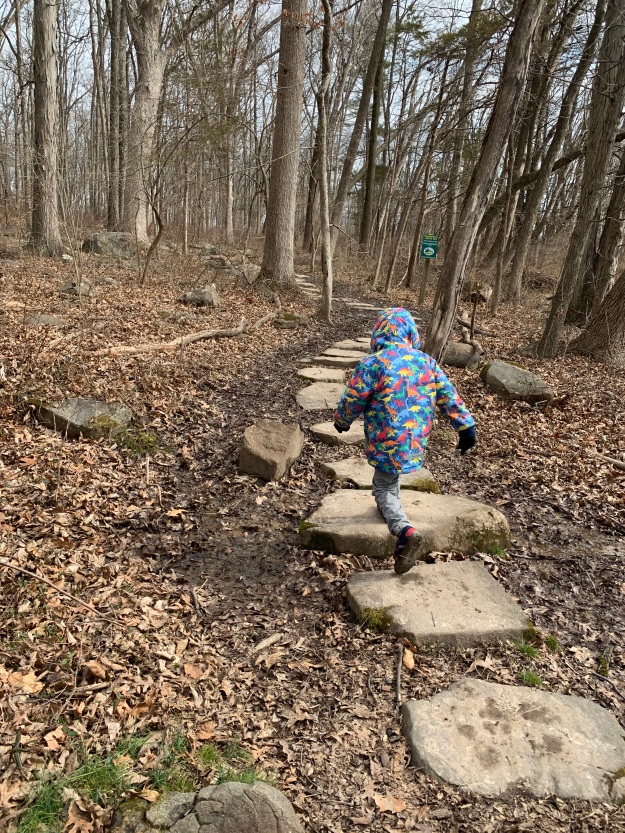
Even at my age, I love stepping stones as much as my kids.

I appreciate the whole body effort of my Littlest. He will hop across all those stones just like his big brother.
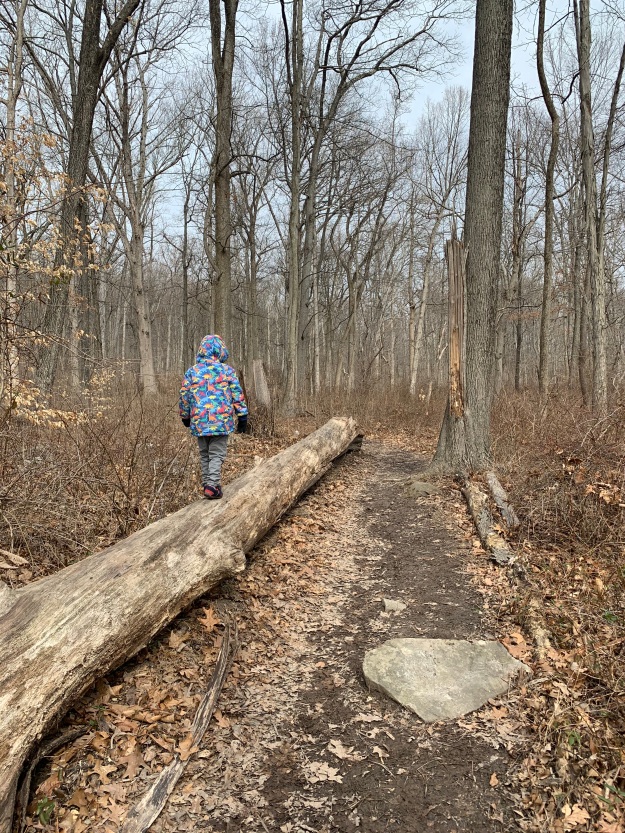
Horizontal logs are an absolute must when perfecting those balancing skills.
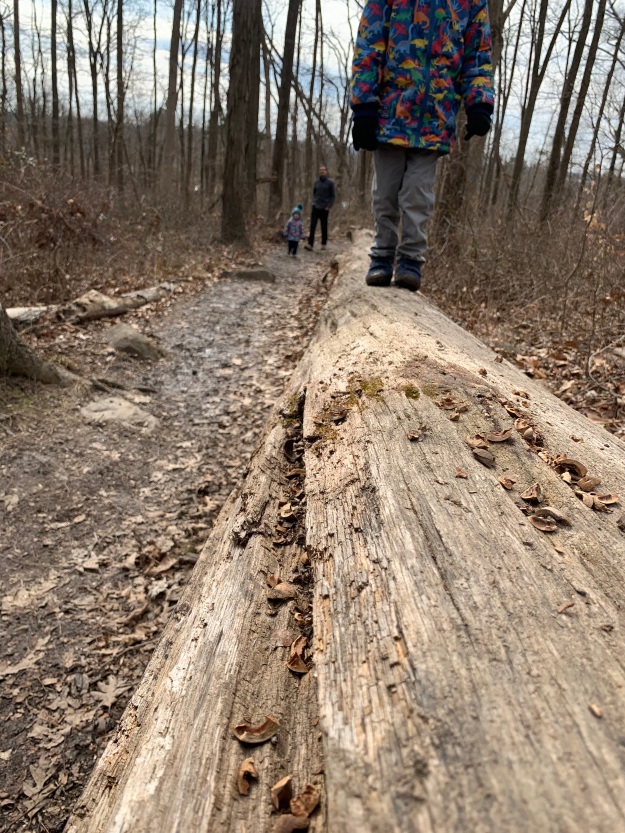
Littlest and I had hiked part of the Blue Trail when he was a few months old and we had stopped at this very same log to look at all of the nutshells. I love how you will see some of the same familiar sights even if you haven’t been on that trail for 1.5 years.

We all get in on the rock hopping fun!
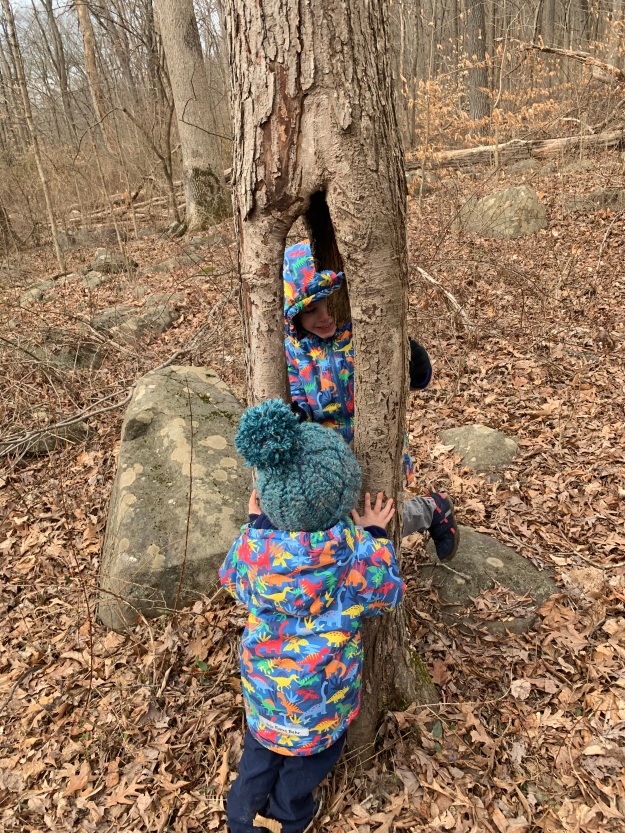
Peak-a-boo!

A Sourland boulder must always be appreciated and climbed.

Shagbark Hickory, Carya ovata, is a popular roosting place for many bat species in the Eastern United States. The Indiana Bat, Myotis sodalis, in particular, likes to hide within the loose bark of this tree.

One of the reasons I love winter hikes is that you can discover the hidden views. During the summer when all of the leaves are out, this view will be completely different.

I believe that this is some sort of non-native Buttercup, possibly Winter Aconite, Eranthis hyemalis.
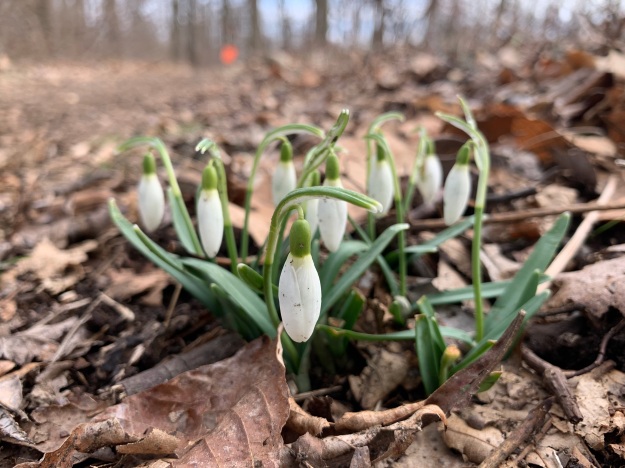
Common Snowdrops, Galanthus nivalis, making an appearance.
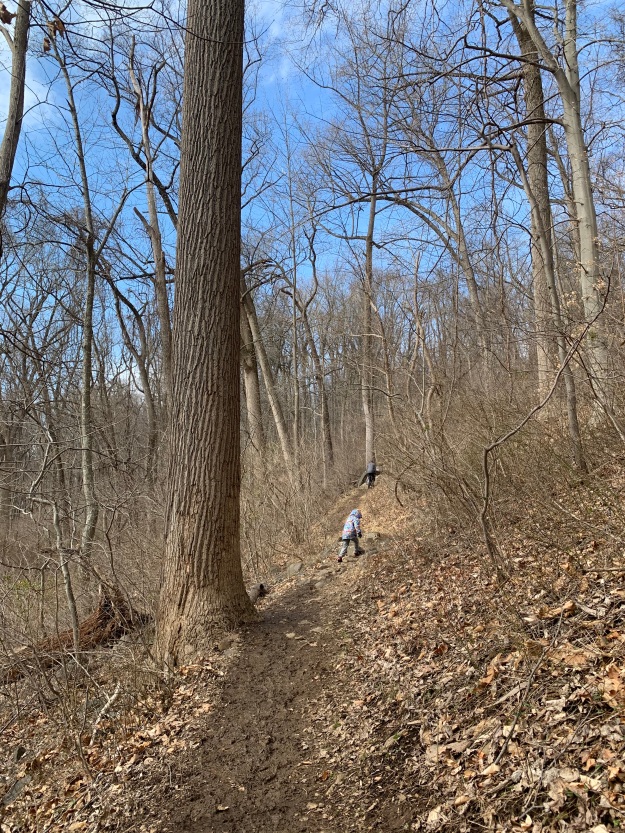
I love all of the big trees on this side of the mountain.

Taking a little break.
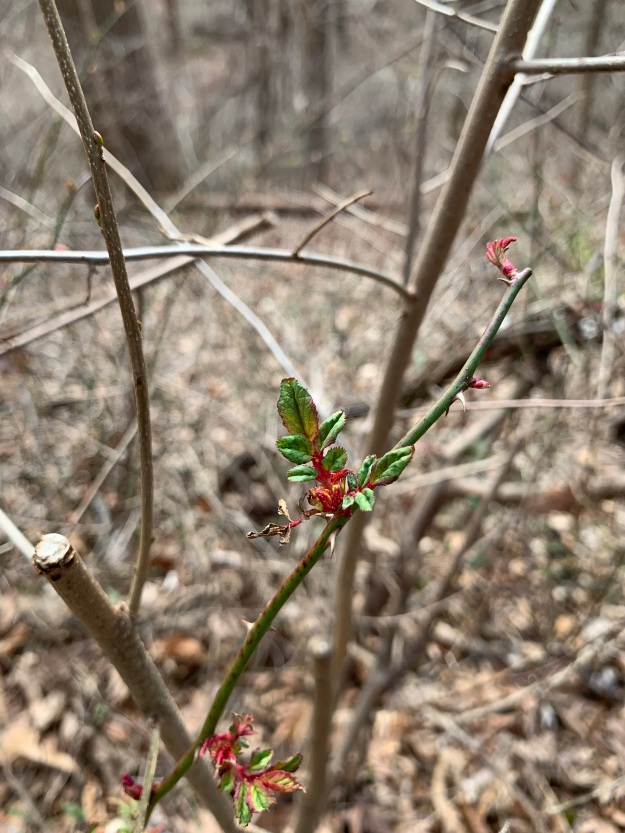
Multiflora Rose, Rosa Multiflora, is already sending out new leaves – in February! It has been alarming how mild this winter has been and I am so afraid of how this affects our ecosystem as a whole. There is such a thin balance between bloom times, insect emergence, migrations, and breeding season that when one thing starts too early, the whole balance is thrown off.

A hardscrabble up these rocks!
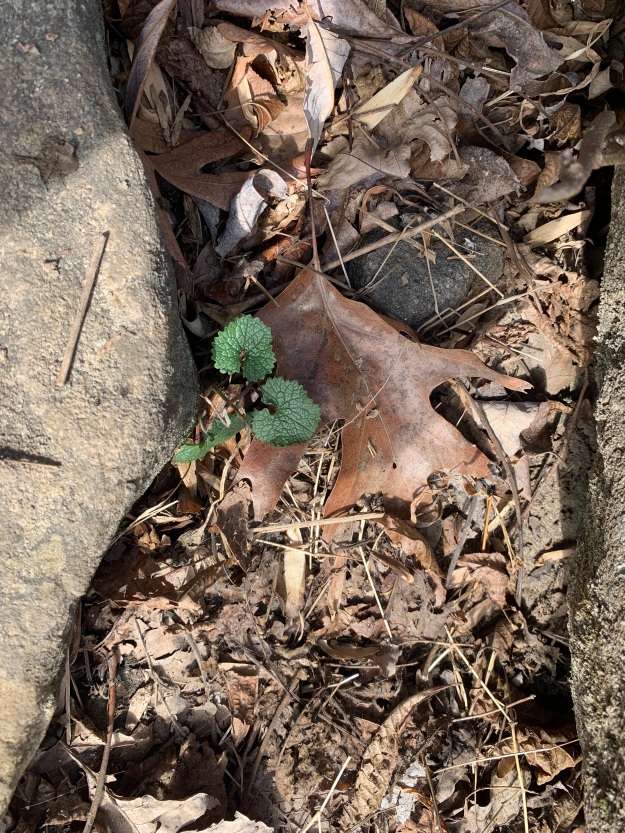
Garlic Mustard, Alliaria petiolata, leafing out early. Unfortunately, this invasive is almost always one of the first plants I see to leaf out in the spring. But let’s be honest, it is still winter! Garlic Mustard is edible and can be substituted for garlic in pesto. Yum!

Running to the world’s edge – also known as the “septic mound”… We usually travel to the higher meadow but when the Wild Boys saw this wide-open view, they took off.
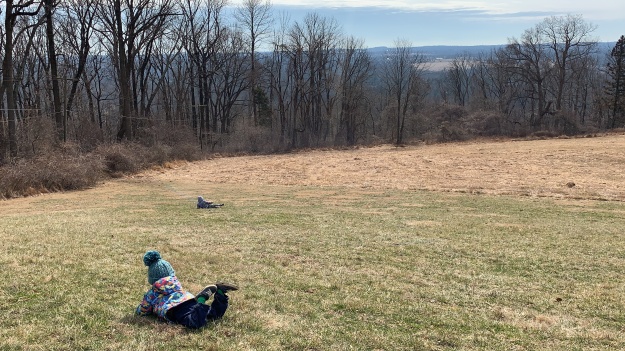
Rolling down the mountain.

Snacks after a hike well done!


 Dinosaurs love to climb boulders!
Dinosaurs love to climb boulders!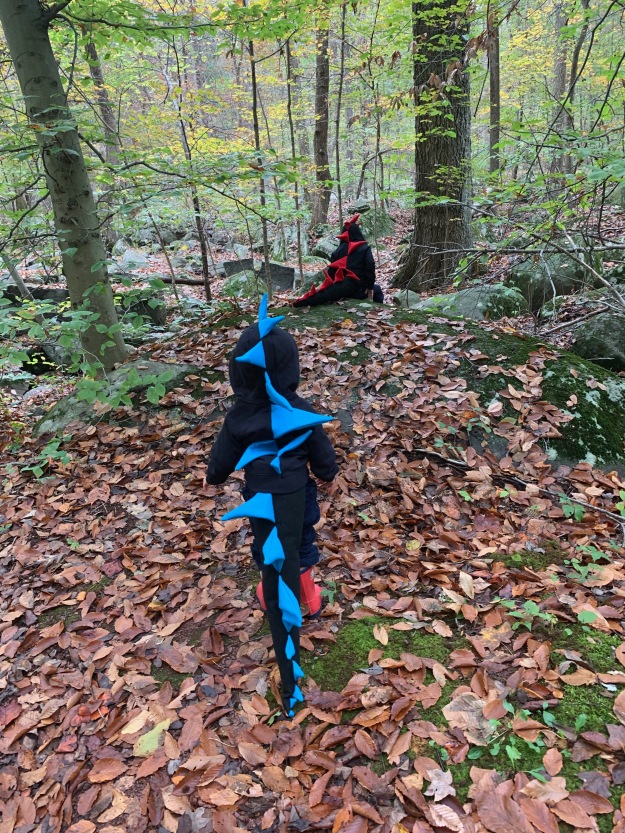 They are off!
They are off!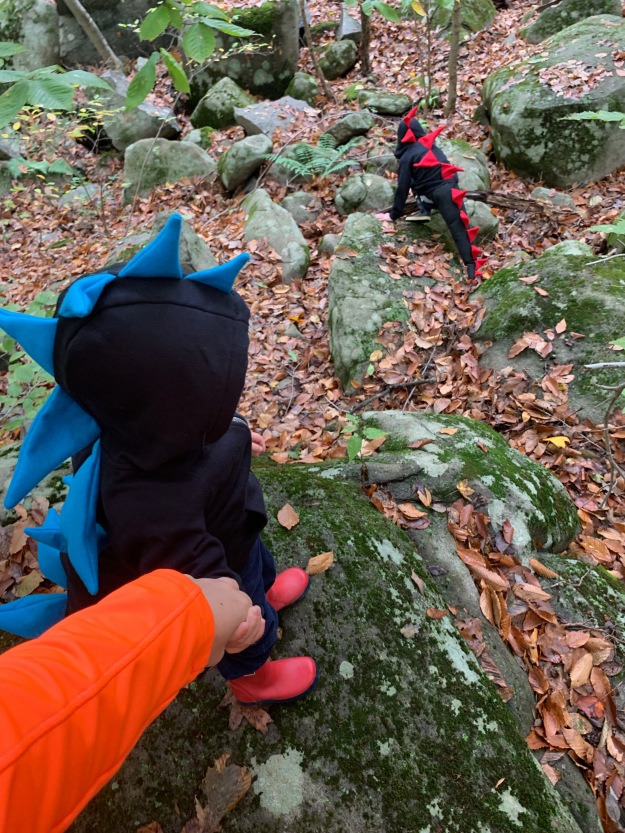 Sometimes, little dinosaurs need a bit of reassurance. I love holding hands with my brave dinosaurs as they explore
Sometimes, little dinosaurs need a bit of reassurance. I love holding hands with my brave dinosaurs as they explore Littlest found an American Beech, Fagus grandifolia, nut.
Littlest found an American Beech, Fagus grandifolia, nut. Summiting the highest point he can find!
Summiting the highest point he can find! My big dinosaur reminds me of an iguana basking in the sun!
My big dinosaur reminds me of an iguana basking in the sun! Sourland boulders.
Sourland boulders. Two dinosaurs planning some mischief!
Two dinosaurs planning some mischief!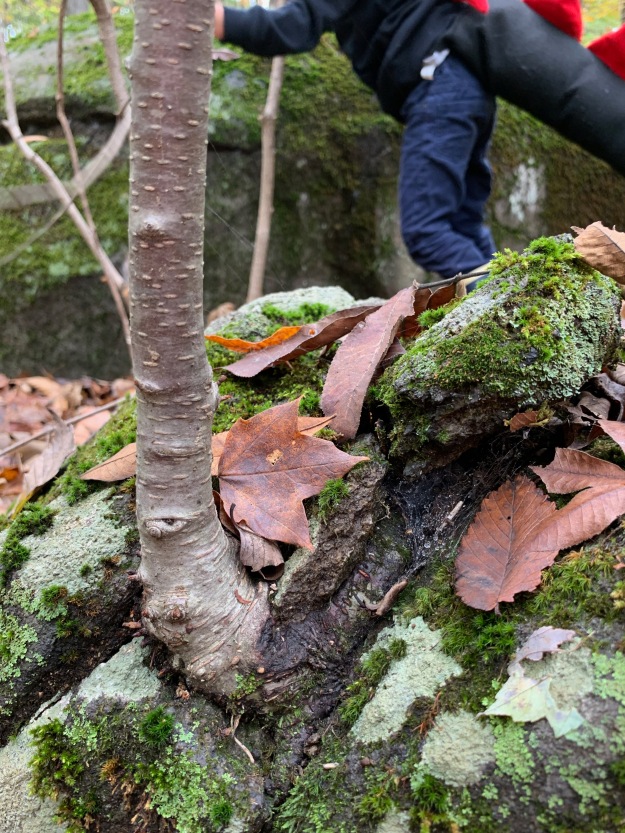 I love how this tree is growing directly on this rock. Where there is a will there is a way!
I love how this tree is growing directly on this rock. Where there is a will there is a way!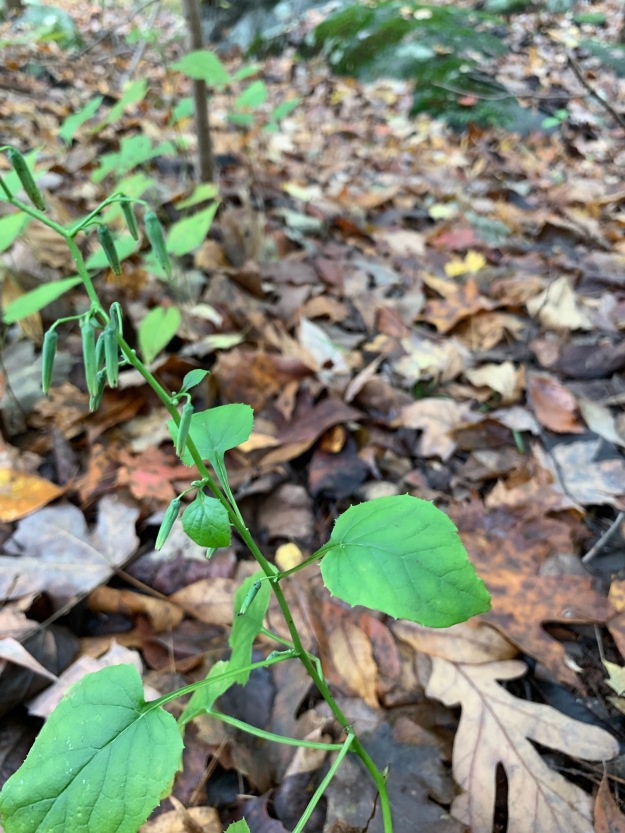 White Rattlesnake Root, Prenanthes alba.
White Rattlesnake Root, Prenanthes alba.  American Witch Hazel, Hamamelis virginiana, seed capsule.
American Witch Hazel, Hamamelis virginiana, seed capsule. American Witch Hazel flower buds. They will be blooming any day now!
American Witch Hazel flower buds. They will be blooming any day now! If there is a boulder, this dinosaur will have to climb it!
If there is a boulder, this dinosaur will have to climb it! The sulfur yellow buds of Bitternut Hickory, Carya cordiformis.
The sulfur yellow buds of Bitternut Hickory, Carya cordiformis. Littlest Dinosaur points the way to go home!
Littlest Dinosaur points the way to go home!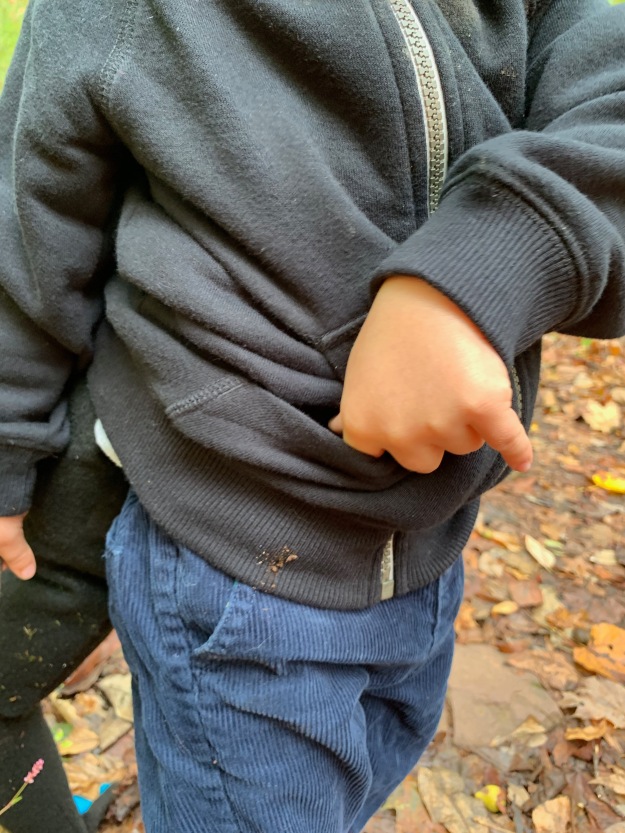 “What are you putting in your pockets little dinosaur?”
“What are you putting in your pockets little dinosaur?” Bitternut, Carya cordiformis, nuts!
Bitternut, Carya cordiformis, nuts! White Wood Aster, Eurybia divaricata (Aster divaricatus), looking so lovely in the October morning light.
White Wood Aster, Eurybia divaricata (Aster divaricatus), looking so lovely in the October morning light. Indian Pipe, Monotropa uniflora, in fruit. Indian Pipe is a parasitic plant and receives its nutrients from a host rather than photosynthesis. The plant is white because it does not contain chlorophyll and as it ages and produces fruit, it turns brown.
Indian Pipe, Monotropa uniflora, in fruit. Indian Pipe is a parasitic plant and receives its nutrients from a host rather than photosynthesis. The plant is white because it does not contain chlorophyll and as it ages and produces fruit, it turns brown.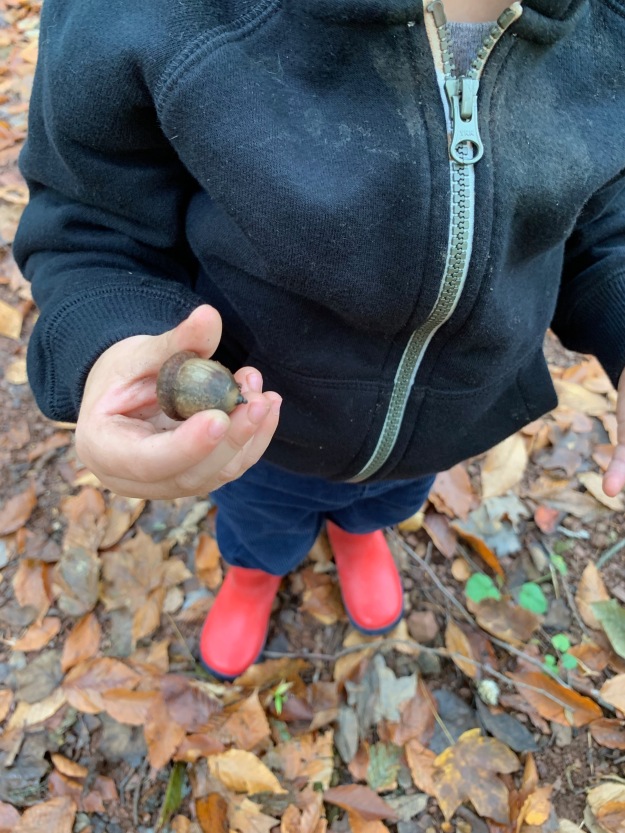 Red Oak, Quercus rubra, acorn!
Red Oak, Quercus rubra, acorn! Shagbark Hickory, Carya ovata, nuts!
Shagbark Hickory, Carya ovata, nuts! The bounty from our adventure!
The bounty from our adventure! My big dinosaur wanted to give back the food he had gathered to the woodland creatures, so he carefully sorted each of the nuts and left them out on the rock to be found.
My big dinosaur wanted to give back the food he had gathered to the woodland creatures, so he carefully sorted each of the nuts and left them out on the rock to be found. August has begun to whisper, “Summer is coming to an end.” I detect a slight early morning chill and I am a little wistful, realizing that it will soon be too cold for short sleeves. The moon rises earlier and sets later and the days are cooler and shorter. August is bittersweet as summer reaches its peak and I must soon say “good-bye” to my favorite season of the year.
August has begun to whisper, “Summer is coming to an end.” I detect a slight early morning chill and I am a little wistful, realizing that it will soon be too cold for short sleeves. The moon rises earlier and sets later and the days are cooler and shorter. August is bittersweet as summer reaches its peak and I must soon say “good-bye” to my favorite season of the year.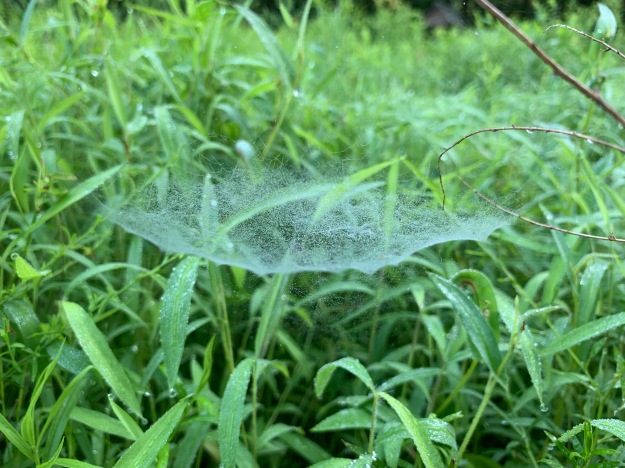 I really like this trampoline web! I didn’t see the owner, but I like to imagine the tiny spider bouncing up and down doing back flips!
I really like this trampoline web! I didn’t see the owner, but I like to imagine the tiny spider bouncing up and down doing back flips! Who is hiding in there?
Who is hiding in there? There you are! A grass spider in the family, Agelenidae.
There you are! A grass spider in the family, Agelenidae.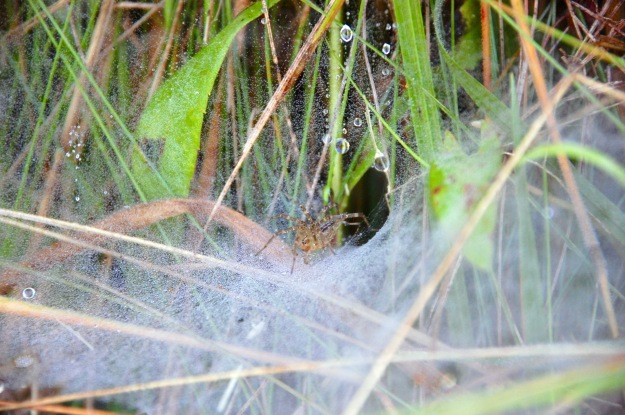 These spiders do not have sticky webs. Instead they run very fast to catch their prey.
These spiders do not have sticky webs. Instead they run very fast to catch their prey. A loose knitted spider web. I love the big loops, heavy with dew.
A loose knitted spider web. I love the big loops, heavy with dew.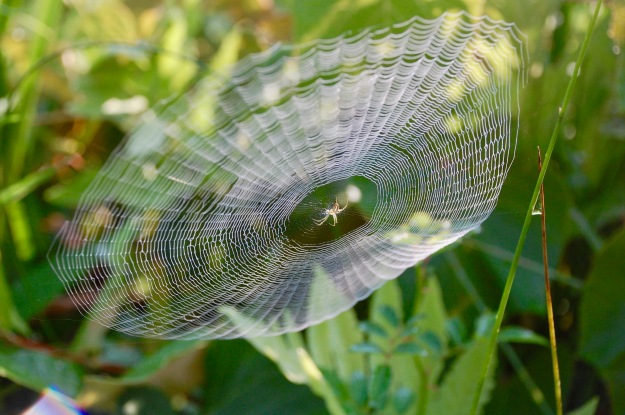 A tight and symmetrical web. I wonder why the center is transparent but the outer circles are not? Perhaps to confuse their prey into flying towards the midpoint of the web?
A tight and symmetrical web. I wonder why the center is transparent but the outer circles are not? Perhaps to confuse their prey into flying towards the midpoint of the web?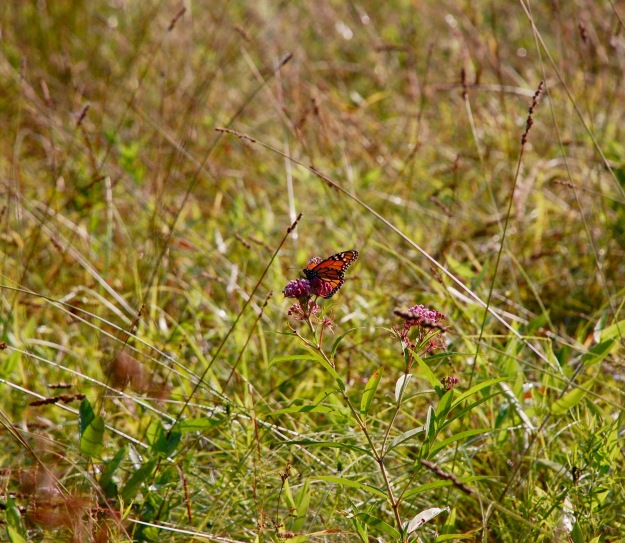 A Monarch Butterfly, Danaus plexippus! It was my oldest who informed me that the Monarchs are the “Kings of the Butterflies”. I then realized that the significance of the name, “Monarch” had eluded me! Children can be wonderful teachers.
A Monarch Butterfly, Danaus plexippus! It was my oldest who informed me that the Monarchs are the “Kings of the Butterflies”. I then realized that the significance of the name, “Monarch” had eluded me! Children can be wonderful teachers.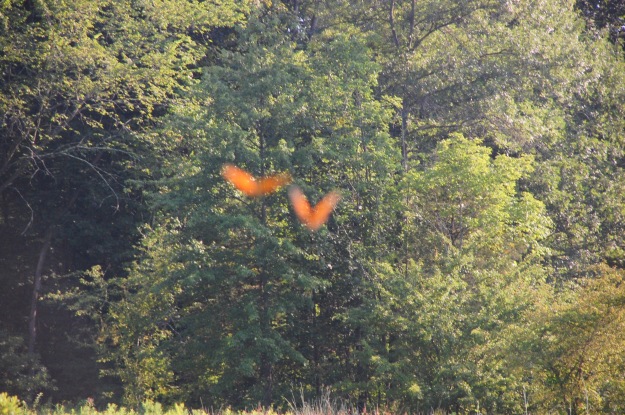 At first, I was frustrated because I could not get a picture of the monarchs flittering about. But I really like this picture of the two Monarchs flying together with the background in focus. It adds to the whimsical beauty of this August morning.
At first, I was frustrated because I could not get a picture of the monarchs flittering about. But I really like this picture of the two Monarchs flying together with the background in focus. It adds to the whimsical beauty of this August morning. This Eastern Tiger Swallowtail, Papilio glaucus, kept teasing me. Every time I tried to get close for a picture, it would flit away.
This Eastern Tiger Swallowtail, Papilio glaucus, kept teasing me. Every time I tried to get close for a picture, it would flit away. I persisted and finally got the picture I wanted! My oldest loves to tell me that butterflies have a proboscis. I don’t think that he has actually seen a proboscis and he is unsure about where the proboscis goes when the butterfly is not eating. Now I can show him! Here is a short video about the Butterfly proboscis
I persisted and finally got the picture I wanted! My oldest loves to tell me that butterflies have a proboscis. I don’t think that he has actually seen a proboscis and he is unsure about where the proboscis goes when the butterfly is not eating. Now I can show him! Here is a short video about the Butterfly proboscis 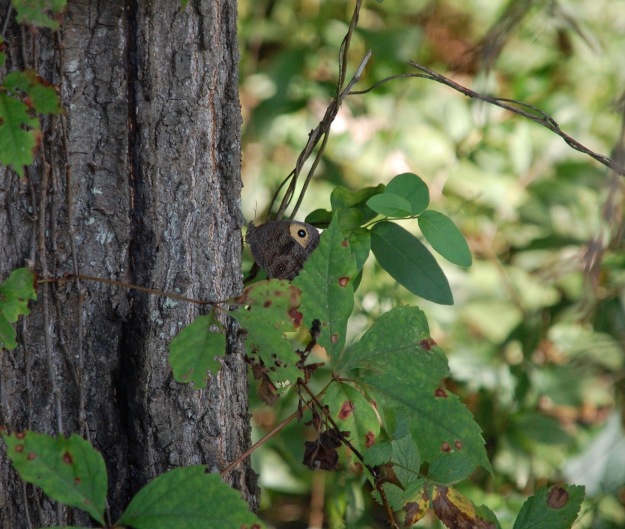 I believe that this Butterfly is a common Wood-Nymph, Cercyonis pegala. I was elated when I realize that wood nymphs are not just imaginary creatures in stories!
I believe that this Butterfly is a common Wood-Nymph, Cercyonis pegala. I was elated when I realize that wood nymphs are not just imaginary creatures in stories! Elderberry, Sambucus canadensis. Whenever I see Elderberries, I always giggle as I recall “Monty Python and the Holy Grail” and the French knight who said “I fart in your general direction! Your mother was a hamster and your father smelt of Elderberries!”
Elderberry, Sambucus canadensis. Whenever I see Elderberries, I always giggle as I recall “Monty Python and the Holy Grail” and the French knight who said “I fart in your general direction! Your mother was a hamster and your father smelt of Elderberries!”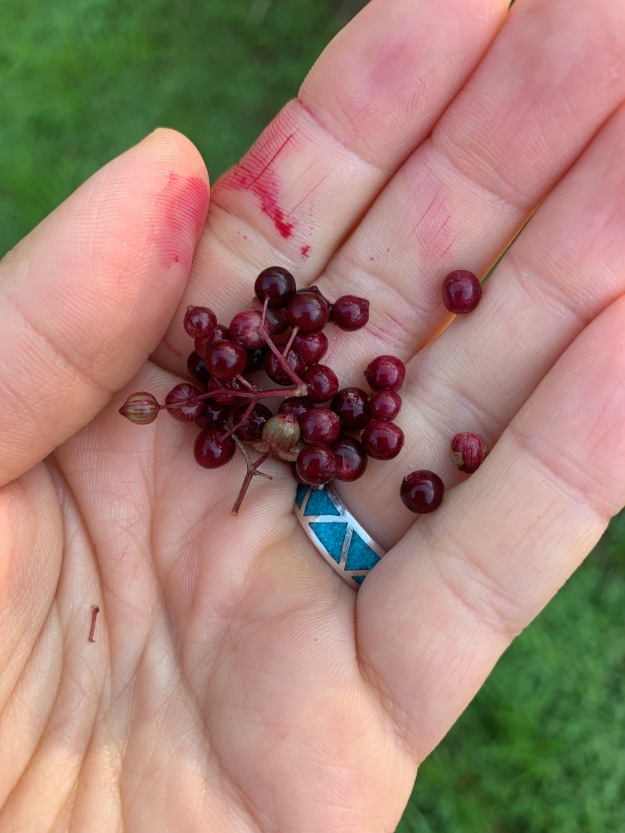 These fruit were not ripe yet, but I still wanted to get a closer look…and to take a whiff in order to know what Elderberries really smell like 😉
These fruit were not ripe yet, but I still wanted to get a closer look…and to take a whiff in order to know what Elderberries really smell like 😉 A side-view of Jewelweed/Touch-me-not, Impatiens capensis. Look at the vents and the tail on this flower! It is absolutely gorgeous!
A side-view of Jewelweed/Touch-me-not, Impatiens capensis. Look at the vents and the tail on this flower! It is absolutely gorgeous! Common Yarrow, Achillea millefolium, dainty and quite beautiful this morning.
Common Yarrow, Achillea millefolium, dainty and quite beautiful this morning.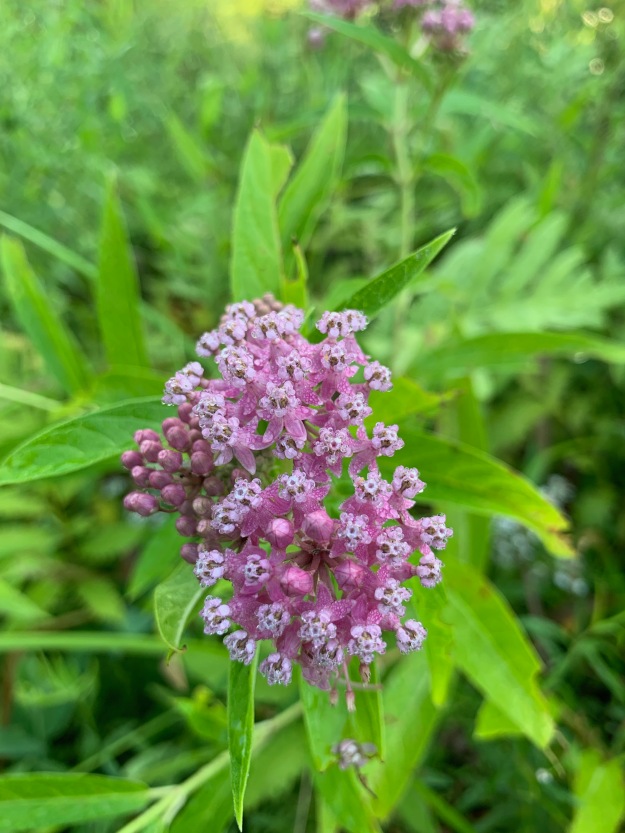 Swamp Milkweed, Asclepias incarnata, both whimsical and tropical in their appearance. I was mesmerized by their charm.
Swamp Milkweed, Asclepias incarnata, both whimsical and tropical in their appearance. I was mesmerized by their charm. Heall-All, Prunella vulgaris, magnificent in this morning light!
Heall-All, Prunella vulgaris, magnificent in this morning light! Queen Anne’s Lace, Daucus carota. A common name for this plant is “Wild Carrot”. Queen Anne’s Lace is a native edible. But BEWARE! There is a common plant that also grows in this area called “Poison Hemlock”, Conium maculatum, and is often mistaken for Queen Anne’s lace because it resembles it so closely.
Queen Anne’s Lace, Daucus carota. A common name for this plant is “Wild Carrot”. Queen Anne’s Lace is a native edible. But BEWARE! There is a common plant that also grows in this area called “Poison Hemlock”, Conium maculatum, and is often mistaken for Queen Anne’s lace because it resembles it so closely.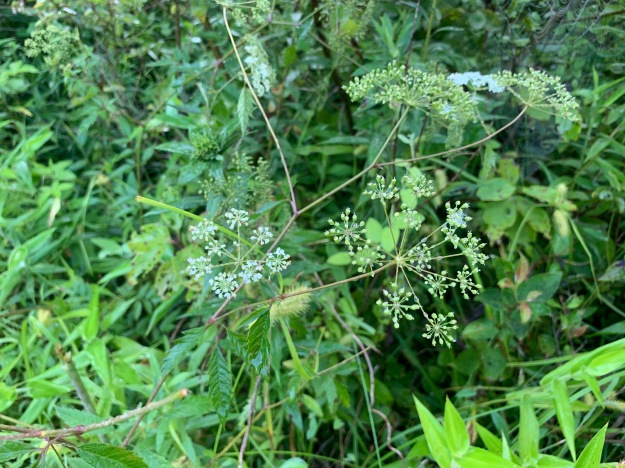 Here is a picture of Poison Hemlock, Conium maculatum. It is often found growing in close proximity to Queen Anne’s Lace.
Here is a picture of Poison Hemlock, Conium maculatum. It is often found growing in close proximity to Queen Anne’s Lace.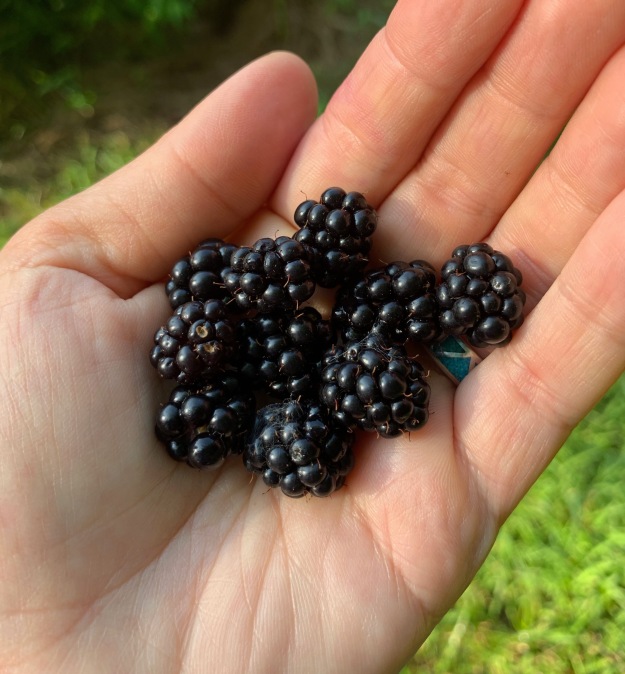 A second breakfast of Blackberries, Rubus allegheniensis, graciously provided by the forest.
A second breakfast of Blackberries, Rubus allegheniensis, graciously provided by the forest. I spy with my little eye a very noisy little bird…
I spy with my little eye a very noisy little bird… A Common Yellowthroat, Geothlypis trichas. A college friend of mine who is a bird enthusiast helped me identify this little bird. Slowly and through practice (and asking friends who dabble in ornithology), I am starting to expand my knowledge of native bird species and identification.
A Common Yellowthroat, Geothlypis trichas. A college friend of mine who is a bird enthusiast helped me identify this little bird. Slowly and through practice (and asking friends who dabble in ornithology), I am starting to expand my knowledge of native bird species and identification. 